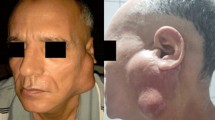Abstract
Perineurioma is a rare, benign tumour of the perineurium, which develops mostly on the nerves of the extremities. The neoplasm related to a genetic mutation on the 22nd chromosome, is a rarity on the vagal nerve branches. Authors report the case of a 15-year-old female with an immunhistochemically verified (focal EMA positive, vimentin, CD56 positive) perineurioma originating from the left recurrent laryngeal nerve. After the removal of the tumour together with the involved 2-cm-long part of the nerve, vocal fold palsy developed with aphonia (left vocal fold was in intermedian position). The treatment had to be chosen carefully as the larynx was still in growth. In our case there was no possibility of spontaneous regeneration, thus we chose lipoaugmentation of the left vocal fold, which does not affect the laryngeal framework, so causes the least harm to the larynx. Following surgery the patient’s voice reached the normal range (before lipoaugmentation perception (0–100): G40 B80 R40 Acoustics: Ji 1.1%, Shi 10.8% Harmonicity: 13.9 dB maximum phonation time (MPT) 5 s after augmentation, Perception: G10 B10 R20, Acoustics: Ji 0.3 %, Shi 2.6%, Harmonicity: 21.2 dB MPT 22 s). This result was permanent, as the regularly performed objective voice evaluations confirmed during the 2-year follow-up.




Similar content being viewed by others
References
Weiss WS, Goldblum RJ (2001) Enzinger and Weiss’s soft tissue tumors, 4th edn. Mosby, St. Louis, pp 1173–1178
Lazarus SS, Trombetta LD (1978) Ultrastructural identification of a benign perineurial cell tumor. Cancer 41:1823–1829
Czigner J, Rovó L, Bereczné Szamosközi A (2006) Endolaryngeal lipoaugmentation of the vocal cord. Fül-Orr-Gégegyógy 43:2–6
Rovó L, Smehák Gy, Tóth L, Szamosközi A, Tóth F, Kiss JG, Czigner J, Jóri J (2005) Laryngostroboscopy and objective acustic analysis for the evaluation of the reversibility of disorders developing during the “early” phase of bilateral vocal cord palsy caused by “simple” suture glottis widening technique. Fül-Orr-Gégegyógy 51:85–92
Dejonckere PH, Bradley P, Clemente P, Cornut G, Crevier-Buchman L, Friedrich G, Van De Heyning P, Remacle M, Woisard V (2001) A basic protocol for functional assessment of voice pathology, especially for investigating the efficacy of (phonosurgical) treatments and evaluating new assessment techniques. Guideline elaborated by the Committee on Phoniatrics of the European Laryngological Society (ELS). Eur Arch Otorhinolaryngol 258:77–82
Ichimura K, Yuasa Y (1993) Molecular biological analysis of neurofibromatosis type 2 gene. Nippon Rinsho 51:2462–2466
Brock JE, Perez-Atayde AR, Kozakewich HP, Richkind KE, Fletcher JA, Vargas SO (2005) Cytogenetic aberrations in perineurioma: variation with subtype. Am J Surg Pathol 29:1164–1169
Emory TS, Scheithauer BW, Hirose T, Wood M, Onofrio BM, Jenkins RB (1995) Intraneural perineurioma. A clonal neoplasm associated with abnormalities of chromosome 22. Am J Clin Pathol 103:696–704
Hirose T, Scheithauer BW, Sano T (1998) Perineurial malignant peripheral nerve sheath tumor (MPNST): a clinicopathologic, immunohistochemical, and ultrastructural study of seven cases. Am J Surg Pathol 22:1368–1378
Gilmer-Hill HS, Kline DG (2000) Neurogenic tumors of the cervical vagus nerve: report of four cases and review of the literature. Neurosurgery 46:1498–1503
Ewy MF, Demmy TL, Perry MC, Krishnan MS, Curtis JJ (1995) Massive phrenic perineurioma mimicking an unresectable cardiac tumor. Ann Thorac Surg 60:188–189
Ugurel S (2005) Serum markers for melanoma. Hautarzt 56:173–184
Hermes H, Lohrer F, Reske S, Ali A (1989) Neurinoma of the recurrent laryngeal nerve—as a case report, an argument for nerve preparation. Laryngorhinootologie 68:244–245
Matejcik V, Benetin J, Danis D (2003) Our experience with surgical treatment of the tumours of peripheral nerves in extremities and brachial plexus. Acta Chir Plast 45:40–45
Rovo L, Jori J, Brzozka M, Czigner J (2000) Airway complication after thyroid surgery: minimally invasive management of bilateral recurrent nerve injury. Laryngoscope 110:140–144
Rosin DF, Handler SD, Potsic WP, Wetmore RF, Tom LW, (1990) Vocal cord paralysis in children. Laryngoscope 100:1174–1179
Gould WJ, Sataloff RT, Spiegel JR (1993) Voice surgery. Mosby-Year Book, St. Louis, pp 67–93
Friedrich G, de Jong FI, Mahieu HF, Benninger MS, Isshiki N (2001) Laryngeal framework surgery: a proposal for classification and nomenclature by the Phonosurgery Committee of the European Laryngological Society. Eur Arch Otorhinolaryngol 258:389–396
Tucker HM (1978) Human laryngeal reinnervation: long-term experience with the nerve-muscle pedicle technique. Laryngoscope 88:598–604
Toth A, Szucs A, Harasztosi C, Matesz K, Pucsok K, Miko I, Sziklai I (2005) Intrinsic laryngeal muscle reinnervation with nerve-muscle peclicle. Otolaryngol-Head Neck Surg 132:701–706
Dedo HH (1992) Injection and removal of Teflon for unilateral vocal cord paralysis. Ann Otol Rhinol Laryngol 101:81–86
Levine BA, Jacobs IN, Wetmore RF, Handler SD (1995) Vocal cord injection in children with unilateral vocal cord paralysis. Arch Otolaryngol Head Neck Surg 121:116–119
Rovo L, Czigner J, Szamoskozi A, Brzozka MA (1999) Endolaryngeal lipoaugmentation of the vocal cords. Otolaryngol Pol 53:709–713
Umeno H, Shirouzu H, Chitose S, Nakashima T (2005) Analysis of voice function following autologous fat injection for vocal fold paralysis. Otolaryngol Head Neck Surg 132:103–107
Sittel C, Plinkert PK (2005) Vocal fold augmentation. HNO 53:6–10
Author information
Authors and Affiliations
Corresponding author
Rights and permissions
About this article
Cite this article
Smehák, G., Rovó, L., Tiszlavicz, L. et al. Perineurioma originating from the recurrent laryngeal nerve, and the phonochirurgical treatment of the developed vocal fold palsy. Eur Arch Otorhinolaryngol 265, 237–241 (2008). https://doi.org/10.1007/s00405-007-0417-7
Received:
Accepted:
Published:
Issue Date:
DOI: https://doi.org/10.1007/s00405-007-0417-7




